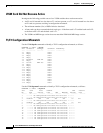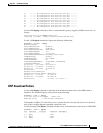
A-4
Cisco VISM Installation and Configuration Guide
Release 3.0, Part Number OL-2521-01 Rev. D0, June 2004
Appendix A VISM and VISM-PR Card Clocking Options
PXM1E or PXM45 Card as Primary Clocking Source
To configure the VISM-PR card as the primary clocking source, complete the following steps:
Step 1 Use the cnfln command to configure a line number—the line that is receiving the clocking source—for
loop clocking.
Step 2 Use the cnfln command to configure all remaining T1 or E1 lines on all VISM cards in the chassis for
local clocking.
Step 3 Use the cnfclksrc command to configure the PXM card as a service module clocking source and specify
VISM and its clocking line as the clocking source.
You cannot delete a line that is configured as the clock source. You must first configure the line to not
be the clock source and then you can delete the line.
Refer to Chapter 5, “CLI Commands,” for more information on VISM commands.
PXM1E or PXM45 Card as Primary Clocking Source
Use the cnfncdpclksrc command to configure the PXM1E or PXM45 card as the primary clock source.
Refer to the Cisco MGX 8850 Installation and Configuration Guide and the Cisco MGX 8000 Series
Switch Command Reference for configuration instructions. Use the following commands to display and
verify your configuration:
• dspncdpclkinfo
• dspncdpclksrc
Revertive and Nonrevertive Clocking
Clocking can be either revertive or nonrevertive. If your MGX switch is configured for a clock source
from a BITS source or PXM line source and the source line goes into the alarm state, a revertive or
nonrevertive recovery occurs.
• Revertive clocking—If a node is configured and the clock source fails (due to a physical failure such
as a loss of signal, the clock frequency drifts out of specification, or a bad frequency), the node
abandons the clock source and finds an alternate clock source. When the original clock source
repairs, the node automatically reverts to using the original clock source.
• Nonrevertive clocking—Similar to revertive clocking, except that when the original clock source
repairs, the node does not automatically revert to the original clock source.


















